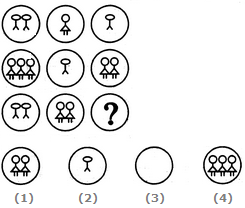Discussion
Home ‣ Non Verbal Reasoning ‣ Analytical Reasoning See What Others Are Saying!
- Question
If white is called black, black is called red, red is called yellow, yellow is called green, green is called blue, blue is called violet and violet is called orange, what would be the colour of human blood?
Options- A. green
- B. black
- C. red
- D. yellow
- Correct Answer
- yellow
- 1. Find the missing figure from the given responses:

Options- A. 1
- B. 2
- C. 3
- D. 4 Discuss
- 2. In each of the following questions which of the answer figures is exactly the mirror image of the question figure when the mirror is held at the given point
Options- A. .
- B. .
- C. .
- D. . Discuss
- 3. Find the question mark
? figure from answer figure:

Options- A. 1
- B. 2
- C. 3
- D. 4 Discuss
- 4. Find the question mark? figure from answer figure:

Options- A. 1
- B. 2
- C. 3
- D. 4 Discuss
- 5.
Find the number of triangles in the figure

Options- A. 12
- B. 10
- C. 18
- D. 16 Discuss
- 6. Two positions of a block are given below. When two is at the bottom what number will be at the top?
Options- A. 6
- B. 5
- C. 4
- D. 1 Discuss
- 7. Select a suitable figure from the four alternatives that would complete the figure matrix.

Options- A. 1
- B. 2
- C. 3
- D. 4 Discuss
- 8. Select the figure which satisfies the same conditions of placement of the dots as in Figure-X.

Options- A. 1
- B. 2
- C. 3
- D. 4 Discuss
- 9. Among the four answer figures, which figure can be formed from the cut-pieces given below in the question figure?
Options- A. 1
- B. 2
- C. 3
- D. 4 Discuss
- 10. Choose the correct mirror image of the given figure (X) from amongst the four alternatives.
 (X) (1) (2) (3) (4)
(X) (1) (2) (3) (4)
Options- A. 1
- B. 2
- C. 3
- D. 4 Discuss
More questions
Correct Answer: 4
Explanation:
According to above given question figures , we can say that
In each subsequent figure similar design is added.
Hence , figure ( 4 ) will come on the place of ? from answer figures .
Correct Answer: .
Explanation:
Answer A
Correct Answer: 2
Explanation:
In the second element the main design has one side more than the main design of the first element.
Correct Answer: 4
Explanation:
The second figure is the water image of the first figure.
Correct Answer: 18
Explanation:
Correct Answer: 4
Explanation:
We follow the given pattern :-
From the two views of the dice it is clear that dice has been inverted as three dots are on the same side.
Therefore, when two is at the bottom, four will be on the top.
Correct Answer: 3
Explanation:
In each row, the number of elements in the third figure is equal to the difference in the number of elements in the first and second figures. Also, the third figure has the same types of elements (if any) as the elements in the first figure.
Correct Answer: 1
Explanation:
In fig. (X), one of the dots is placed in the region common to the circle and the triangle only and another dot is placed in the region common to the square and the triangle only. In each of the three alternatives (2), (3) and (4), there is no region common to the square and the triangle only. Only fig. (1) consists of both the types of regions.
Correct Answer: 1
Explanation:
NA
Correct Answer: 4
Comments
There are no comments.Programming
Copyright ©CuriousTab. All rights reserved.
